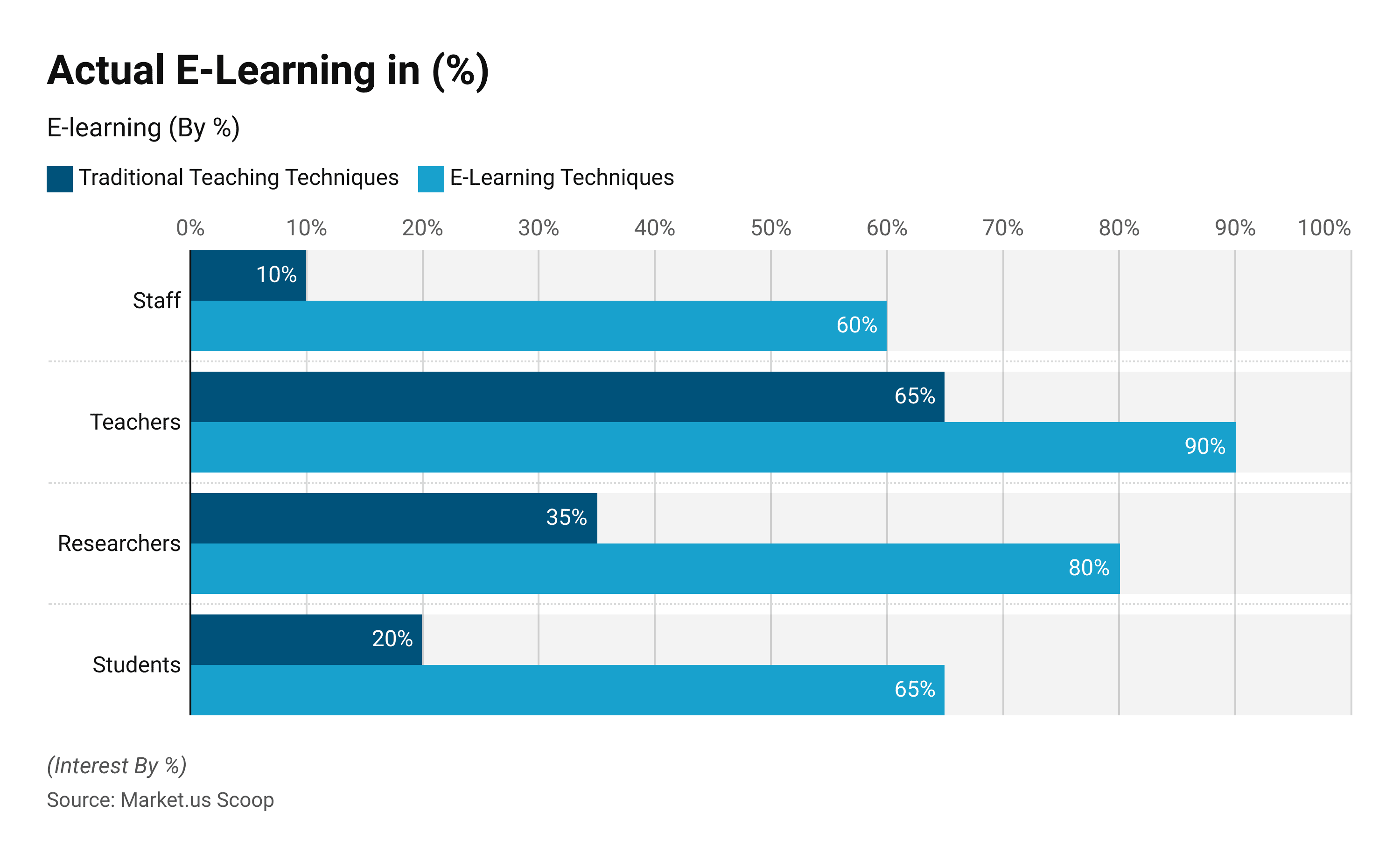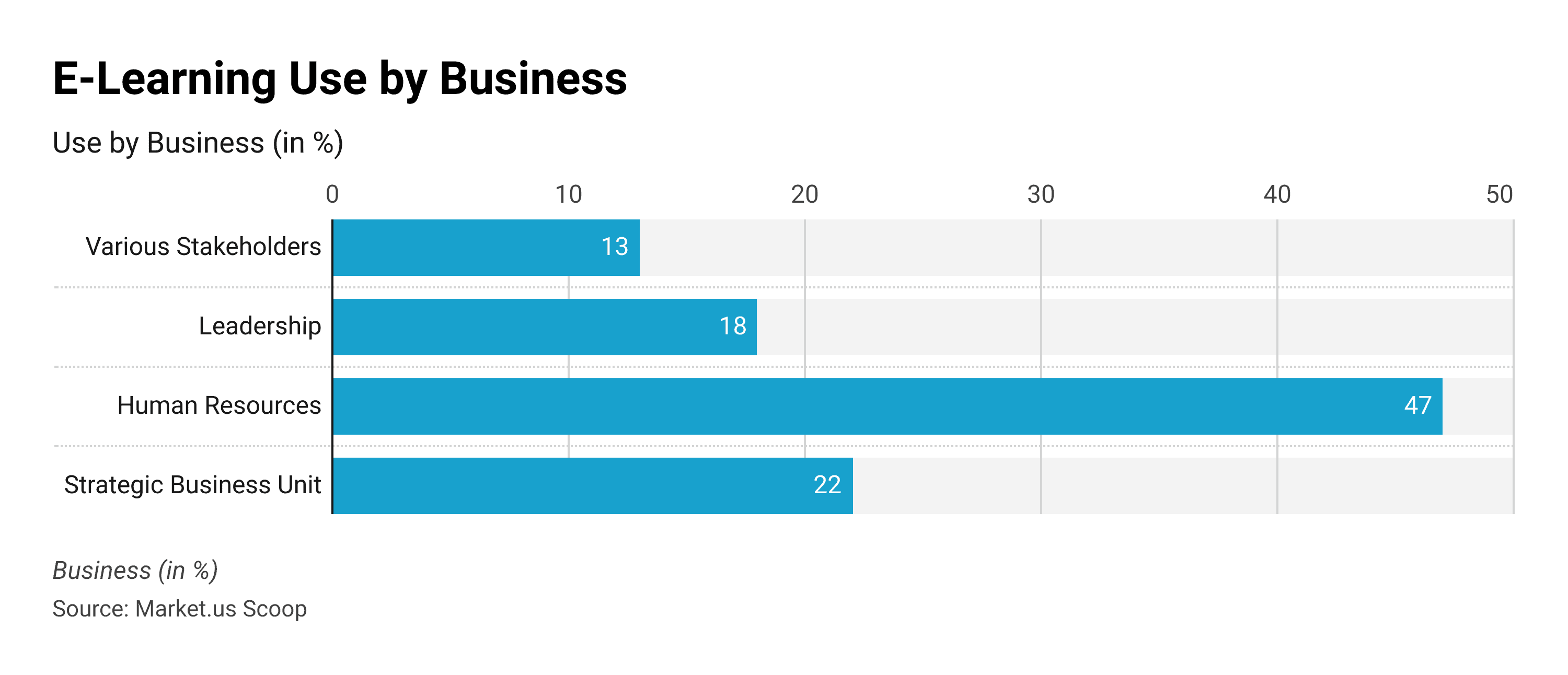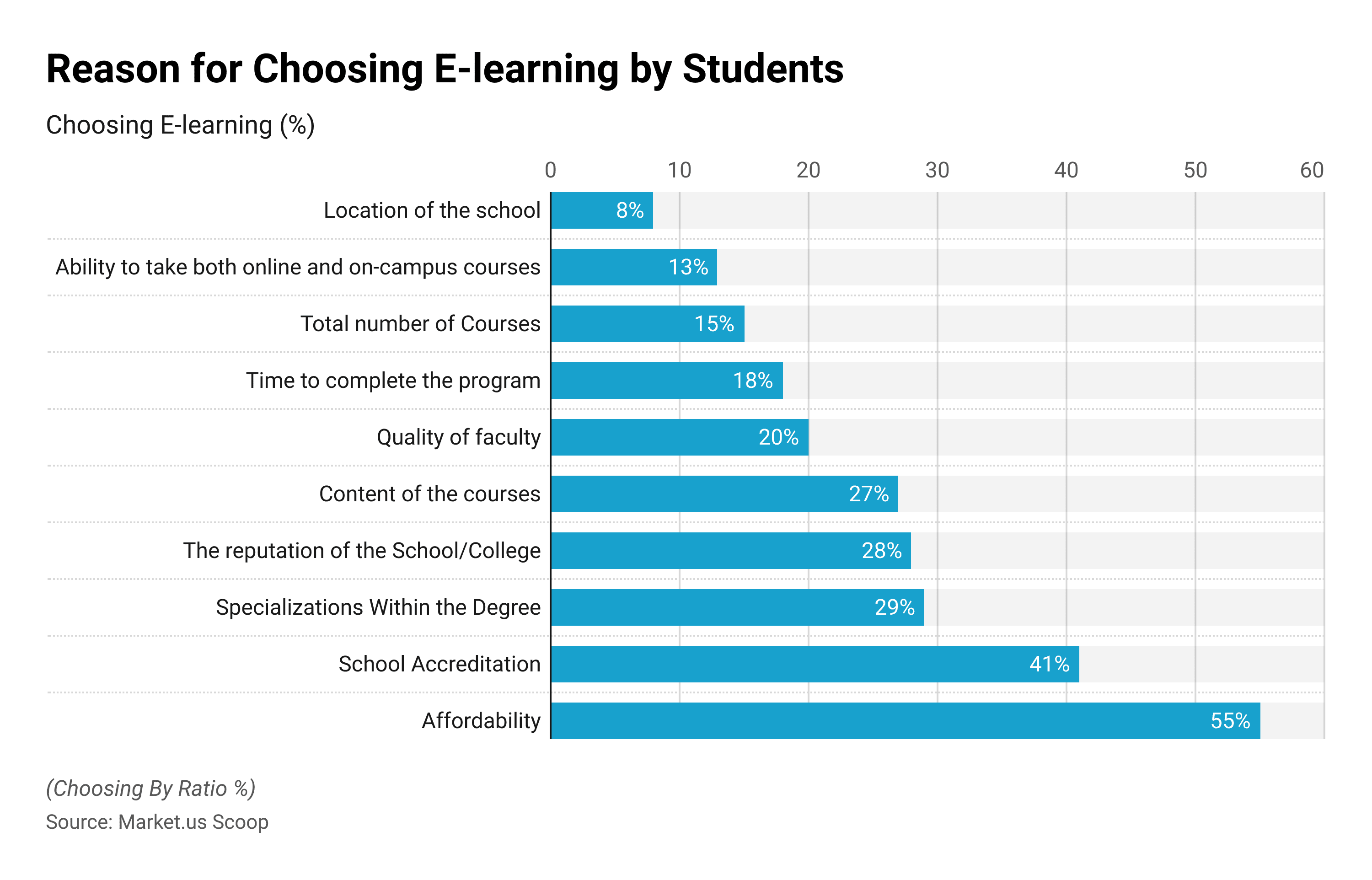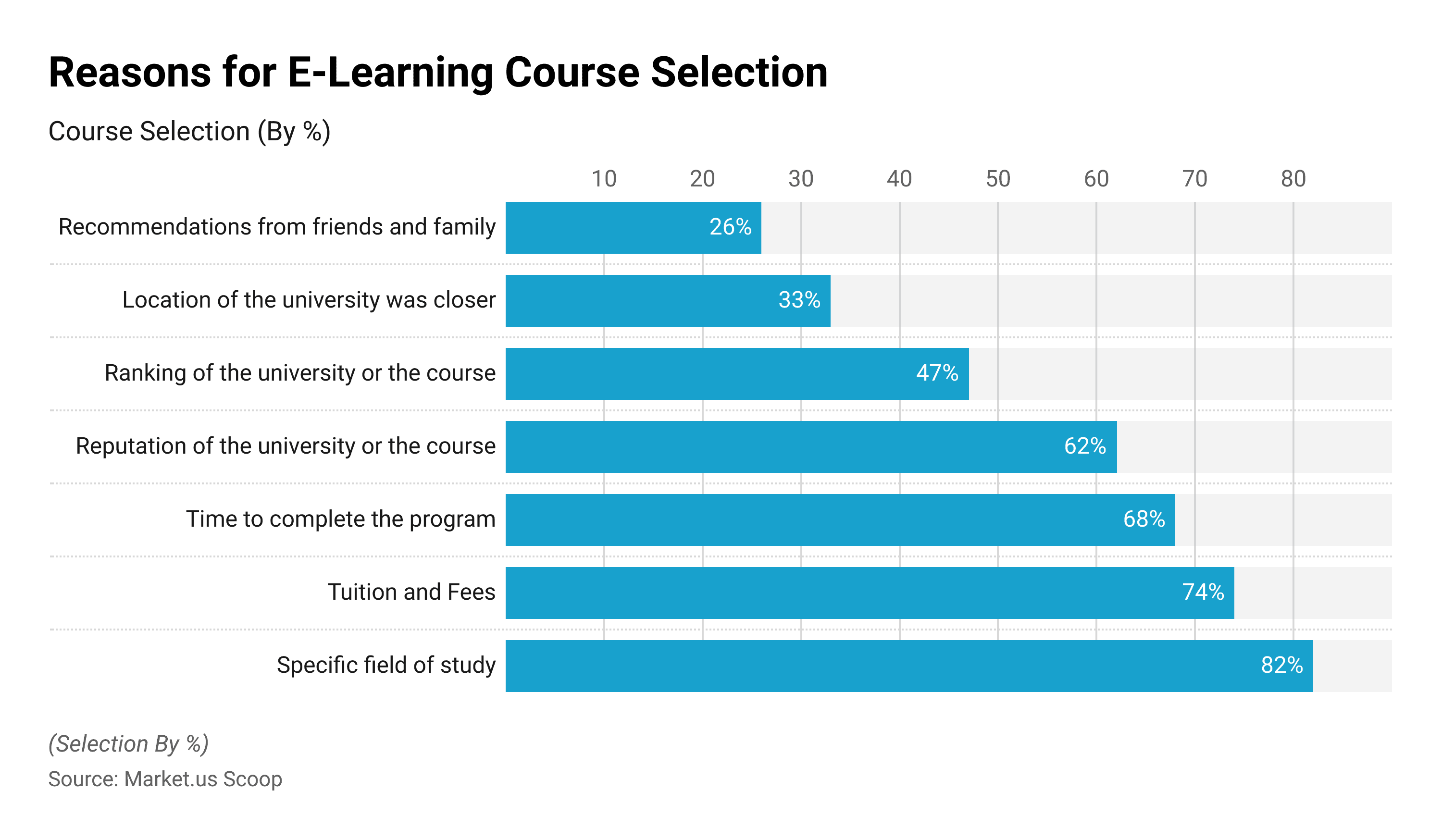Table of Contents
- What is eLearning?
- Top 2023 eLearning Statistics
- Recent eLearning Statistics (What’s New?)
- eLearning Statistics on Business
- Globally eLearning Statistics
- E-learning for Academics Statistics
- Online eLearning Platforms
- elearning in Higher Education Statistics
- eLearning Statistics Trends for 2023
- Fun Facts about eLearning Statistics
- Online Course and MOOC eLearning Statistics
- Major Notable Changes in eLearning Statistics
- Best E-Learning Apps in 2022
- Recent Developments
- FAQ
What is eLearning?
eLearning Statistics: In 1999, the term “eLearning”, short for “electronic”, was created. eLearning is further known as online learning and refers to the learning that occurs at a distance.
eLearning contains a broad range of courses from online college courses for K-12 students to employer training courses.
These digital resources and web applications, such as course management systems, facilitate this technological form of education.
They allow students to communicate with their professors and classmates through email or chat sessions, during taking online classes, downloading course materials, and doing other related activities.
Students usually need only a device like a laptop, tablet, or smartphone with Wi-Fi to participate in eLearning. The low entry barrier makes eLearning accessible and provides other advantages.
In the digital age, many trends have taken off quickly. Its growth has become exceptional and is not showing signs of relapsing.
Distance learning, or E-learning as it is commonly known, doesn’t take place in the traditional classroom setting where a teacher regulates and moderates information.
Top 2023 eLearning Statistics
Here are some of the more famous stats to get you started:
- By 2025, the global e-Learning Corporate Compliance Training Market is projected to be US$ 3,019.3 Mn in 2018 to reach US$ 8,111.3 Mn by 2028 at a CAGR of 10.4%.
- E-Learning Market will be worth more than 315 billion dollars in 2023, and it is expected to grow at 20% CAGR between 2022 and 2028.
- 73% of US Students want to continue online classes following the pandemic.
- 90% of companies provide their employees with some form of digital training.
- 68% of employees prefer to learn on the job.
- In just five years, the number of Coursera users has grown by 438%.
- By 2027, the number of users of online learning platforms is expected to grow to 57,000,000.
- Between 2022 and 2028, the mobile E-learning market is expected to grow by 25%.
- E-learning is credited with a 42% increase in revenue by companies.
- Byju’s, an E-learning startup in India, is India’s largest and the 13th largest Unicorn in the world. Its valuation is $22.6 billion.
Recent eLearning Statistics (What’s New?)
Online learning has become more popular in recent years because of technological advancements and modernization. Here are some of the most recent statistics about online learning and how they affect global education.

eLearning Statistics on Business
- 93% of global firms switch to online education because it’s convenient and easy to implement during pandemic situations. Even if a company doesn’t switch to online learning, it will still use it as an alternative.
- 58% of employees prefer self-paced online learning. This shows that many employees take eLearning courses during their free time, after work, or on weekends.
- 77% incorporated eLearning in their work to learn the skills in demand for their desired field. This resulted in a faster workflow.
- Studies show that employees who attend eLearning courses have higher workplace morale than those who don’t.
- 58% of employees prefer self-paced online learning. This shows that many employees take eLearning courses during their free time, after work, or on weekends.
- Corporate sectors take 45% less time to learn e-learning than the traditional in-person method. This is because it creates chaos in the schedule and disrupts the workflow.
- The income generation of 42% of companies who used eLearning modules increased due to obvious reasons because the learning could be applied practically. The value of the company increases and it starts to rank at the top.
Sources: (Finances online, NCES, E-learning Industry, Papers Owl, eLearning Industry, Tech Jury)

Globally eLearning Statistics
- The US and Europe account for 70% of all eLearning traffic.
- 60% faster than physical classes in learning and observing. This means that e-learning can be digested and covers a lot of material quickly.
- A decline of $33 billion in self-paced e-learning systems by 2021. showed that reports indicated most people preferred e-learning with live classes.
- A $38 billion increase in the market for mobile exclusively has been recorded. This shows that users prefer to learn on portable devices while on the go.
- The US and Europe account for 70% of all eLearning traffic.
(Source: Skill Scouter, Papers Owl, E-Learning Industry, Finances Online, Skill Scouter)
E-learning for Academics Statistics
- In 2021, 50% of students following academic curricula were using eLearning. Most schools have already begun integrating eLearning into their curriculum.
- 40% of college students say that eLearning is more effective than classroom training and that the modules are simpler for better understanding.
- E-learning Classes promise a 72% Success Rate in comparison to standard teaching modules. In-person classes still top the charts according to the statistics.
- 36% of students say that structured lessons and personalized instruction are benefits of e-learning. Students can adapt easily to tutoring.
- Wiley’s survey reveals that over half of the 1500 students chose online education because it is cheaper than a college.
- 73% of students in the USA would like to continue online classes even after the pandemic. These figures come from a Digital Pulse Learning study of more than 1400 students.
- Online learning allows 25-60% more learners to retain the material compared with traditional methods.
(Sources: Skill Scouter, Statista, EdTech Magazine, Statista, Wiley, Shiftelearning)
Online eLearning Platforms
- The user penetration of online learning platforms will be 11.6% by 2023, and 16.6% by 2027.
- Revenue from online learning platforms will reach $2.85 Billion by 2023.
- Udemy is the leading online learning platform with a database of over 10 million students. Udemy produces high-quality material in many niches and categories.
- The e-learning market on MOOCs could reach $25.55 billion over the next few years and cover the path to a whole new era of online learning.
- By 2023, Masterclass will offer more than 150 courses in various categories.
- Masterclass offers classes ranging from 2 hours to 5+. These classes are divided into different lessons.
- Online learning platforms generated a total of $47 billion in revenue, indicating that the majority of users prefer electronic learning.
- The top 500 instructors on Skillshare earn an average of $2000 per month.
- SkillShare will have over 13 million users as of 2023 and 355,000+ classes.
- The majority of Udemy courses (90%) are paid
- Teachable is the second most popular online learning platform in the world, after Udemy (35 million).
(Source: Skill Scouter, Tech Jury, Masterclass, Forbes, Think Impact, Skill Scouter)

elearning in Higher Education Statistics
In the world of higher education, eLearning is becoming more popular. Post-secondary education students tend to be more interdependent. Some work full-time while others are part-time. Parents with children also play a role. The fact that eLearning can be self-paced in general makes it more convenient for students than the traditional chalk and a-board method.
In addition, many prestigious institutions, like Harvard and Oxford, offer their courses via eLearning. The learning materials can be accessed without being on the campuses. timeline maker for students helps students manage their time more effectively to accommodate all classes and other activities.

More Interesting Facts About eLearning Statistics
- 77% of academic leaders rate online education’s learning outcomes as equal to or better than those from face-to-face training.
- 60% of online students are working full-time. Mobile learning is used by 52% of people in the mobile learning field in bed after they wake up. And 46% use it before going to bed.
- Online graduates who earn between $85 and $150k per year are 29%.
- Online students studying business make up 33%.
- BBC survey from 2003 found that micro-learning modules could improve retention and application by 30%.
- Over 80% of undergraduate online students have credits that they can apply to their degree requirements.
- Graduates from online degree programs earn an average of $84,000 per year. 29% earn between $85,000 and $150,000.
- Academic leaders are now at a new high, 69.1%, who say online learning is crucial to their long-term strategies.
- Online degrees are now offered by 62.4% of institutions of higher learning, which previously only offered online courses.

COVID-19 Impact on E-learning. Will it continue in 2023?
COVID-19 has caused a global pandemic in many ways. The e-learning industry is one of those affected.
- For efficient learning, 43% of educational establishments have begun to explore eLearning modules.
- Wiley’s survey found that 59% of respondents said the pandemic had made them consider enrolling in an E-learning course.
- Mobile e-learning is one of the fastest-growing markets in the sector. The Mobile E-learning Market is expected to continue growing at a CAGR of 25% between 2022-2028. The increase in smartphone usage due to the pandemic is a major factor.
- 98% of examinations around the world are now conducted in online mode despite competency and traditional protocol.
(Source: Admissionsly, Wiley)
eLearning Statistics on Course Selection and Enrolment
- “Specific field of study “is a leading factor in online college selection for students in the United States.

eLearning Statistics Trends for 2023
- Artificial Intelligence: AI is now more than just a simple command on a smartphone. It has also made its way to E-learning. AI can now guide users in their learning process. Not only that, but it allows for personalization. You can have a competitive advantage if you harness the power of AI quickly.
- Mobile Learning: Smartphones can do anything today. It was a fantasy a few short years ago, but now it is a reality. You can run your entire business using a smartphone. E-learning, like everything else these days is done on smartphones. You can reach a wider audience if you optimize your course to be used on mobile devices. After the pandemic, smartphone usage has increased dramatically
- Micro-Learning: Breaking up hour-long lessons into smaller lessons lasting a few moments.
- Augmented Reality: AR can increase student engagement by allowing students to actively interact with the material, rather than simply receiving it verbally. This technique has many benefits, including improving knowledge retention and adding value to lessons that are best taught in real-world scenarios.
- Gamification: To improve learner engagement, game-like elements can be included in e-learning plans. Leader’s boards, for example, can add a competitive element to online learning, motivating students to achieve their goals while competing with each other.
Fun Facts about eLearning Statistics
- The first E-Learning program was developed in 1960 by the University of Illinois. Students were taught math skills using a computer.
- Mobile eLearning or mLearning is gaining in popularity, with 67% using mobile devices to access courses.
- One study showed that eLearning could reduce the amount of time it takes to learn a new subject by 60% compared with traditional classroom instruction.
- E-learning is environmentally friendly as it reduces the amount of paper used and the need to travel physically to a classroom.
- E-learning does not only apply to traditional academic subjects. It is also used for professional training, language acquisition, and even fitness.
- Online courses provide greater flexibility and accessibility for students who have disabilities or live in remote areas.
Online Course and MOOC eLearning Statistics
Most learning institutions now offer Massive Open Online Learning (MOOC). MOOCs are a great way to learn for both learners and trainers, as most courses online are free.
Massive open-source courses (MOOCs) are also on the rise, and they provide quality education with professional content.
- The MOOC market was worth 5.16 billion in 2019.MOOC is expecting a 29% growth per year on the market in 2020-2025.
- North America accounts for 29.4% of the global MOOC Market. Online classes are offered by 22 out of the top 25 American universities. In the years 2020-2025, MOOCs in the Asia-Pacific region will be the fastest-growing market.
- 73% of students do not know what MOOCs are.
- MOOCs will have a share of the market estimated at $21.4 billion in 2025.
- EdX created by MIT & Harvard is an example MOOC with over 20 million users & over 70 million enrolments.
- 79% of MOOC users have a degree. 44% hold a postgraduate.
- Online courses for school-related purposes are taken by people between the ages of 5 and 17 years old.
- Online courses are cheaper with credit hours starting at $12 and going up to $66.
- 87% of people use mobile phones to look for online courses.
- The completion rates for MOOCs are lower than 13.3%.
- Most of the students taking US-based online courses reside in the US. This number is up to 99%.
Major Notable Changes in eLearning Statistics
- Coursera can increase the number of learners from 45 to 76 million by 2020.
- Edx can improve the learning of 24 million learners to 35 million, which is a significant improvement.
- Future Learn will provide 23 degrees this year, and 28 degrees in 2020.
The Challenges of Online Learning.
Physical learning is harder than one-on-one training. Online learning is not any easier.
- Students struggle to adapt, as the traditional classroom setting was their only learning method.
- In this industry, technical issues are common because these platforms rely entirely on technology.
- The challenge of computer literacy also exists because online learning tools use computers and not all students have the necessary skills.
- The ability to manage time is another issue, especially when exams are taking place.
Leading E-Learning Platforms by Market Share
To facilitate online learning, the infrastructure was required. The number of online platforms has increased. These platforms offer learners, trainers, and other stakeholders the tools and services they need for online education.
They also help with managing learning resources, delivering them, and even creating a business model.
- Udemy has over 50,000 tutors and 40,000,000 students.
- edX: This online learning platform has partnered up with other learning institutions to offer more than 8,004 online courses.
- Skillshare: This platform has around four million users, and approximately 24000 courses.
- Coursera has 23,000,000 users and is partnered with other educational institutions.
- Learn from LinkedIn: There are over 16,000 classes in seven different languages and two subscription options. The monthly fee is $29.99 and the annual fee is $239.88.
Best E-Learning Apps in 2022
- BYJU’s Learning
- Udemy
- Khan Academy
- edX
- Coursera
- Duolingo
- SoloLearn
- Skillshare
- LightBot
BYJU’s Learning
BYJU’s Learning is an online learning app based in India. Students can choose from a wide range of modules and content. BYJU’s Learning, founded in 2011 by Byju and Divya Raveendran, is a learning platform for students.
Key points
- BYJU”s Learning targets students from K-12.
- BYJU’s Learning, India’s largest and one of the world’s largest educational apps, has over 100,000,000 downloads and more than 6.5 million subscribers.
- BYJU Learning is a specialist in maths and sciences, even though the app covers almost all subjects that students from K-12 need.
- The app uses videos, games, and tasks to teach.
- BYJU’s Learning is leading the market for educational apps with its free live classes.
Availability
- Android
- IOS
Udemy
Udemy’s wide range of courses has made it one of the most popular online educational apps. Udemy was launched in 2010 by Eren Bali Oktay Kagler and Gagan Bibiyani.
Key points
- Udemy offers courses in 65 languages
- Udemy offers the largest variety of courses in the world, with over 1,96,000.
- Udemy’s user base has grown to nearly 52 million users by 2022.
- Udemy aims to attract young adults with its diverse courses.
- Students can access lectures, videos, practical tasks, certificates, and more through the app.
- Udemy’s course fees are comparable to other options.
Availability
- Android
- IOS
Khan Academy
Khan Academy is bringing a revolution in the educational app sector. The app has taken a huge step in its business model as all of its content is free for everyone. Sal Khan is the founder of the educational platform as he launched the app back in 2008.
Key points
- Khan Academy’s non-profit model is the most important feature.
- Khan Academy offers education in 50 languages
- Khan Academy is a free online educational resource that has more than 48 million users in 190 countries.
- It is not just maths and sciences that are covered by the platform. There are also videos about humanities, arts, and economics.
- Khan Academy does not have a specific customer in mind as its goal is to provide free education.
Availability
- Android
- IOS
Coursera
Coursera is a US-based educational app launched in 2012 by Andrew Ng and Daphne Koller.
Key points
- Coursera’s courses are aimed at the 18-55 age group.
- Coursera now has more than 82 million registered users
- This app has more than 3500 courses.
- Coursera offers courses in modern topics, such as machine learning and AI. Machine learning, AI, and programming are examples.
- Coursera offers courses from 29 globally recognized universities.
Availability
- Android
- IOS
Duolingo
Duolingo, a US-based app for learning languages, helps users to learn new ones. The app was founded in 2011 by Luis von Ahn and Severin Hacker. Duolingo has become one of the most popular language-learning apps in the world.
Key points
- Duolingo provides free language-learning programs
- Duolingo allows you to learn more than 30 languages.
- Through games, the app helps a user learn a new tongue in a fun way.
- Duolingo is used by more than 500 million people worldwide
- Subscribe to the app and enjoy ad-free content
Availability
- Android
- IOS
SoloLearn
SoloLearn, a world-famous app for coding instruction, is available in many languages. Yeva Hyusyan founded the app in Armenia in 2014. The app offers a comprehensive education in coding.
Key points
- Anyone over 12 can use SoloLearn
- SoloLearn is used by over 21 Million users
- SoloLearn offers 25 different categories, including Python, JavaScript, and HTML.
- SoloLearn’s subscription plans are quite affordable
- The exercises in the course can be repeated, so you can review them.
Availability
- Android
- IOS
Skillshare
Skillshare, a US-based application, helps students develop their creative skills. The app offers classes in topics such as arts, entrepreneurship, and productivity. Michael Karnjanaprakorn founded the app in 2010 with Malcolm Ong.
Key points
- Skillshare encourages and promotes the creative approach. Skillshare is aimed at people who have a creative mindset.
- Skillshare is expected to have 12 million users by 2022.
- This app offers online courses and course resources
- Skillshare’s group mode is an important feature.
- Skillshare also offers workshops that are characterized by the same creative approach and creativity of students.
Availability
- Android
- IOS
LightBot
LightBot, a learning app from Canada, is available for download. This app teaches coding using games. Danny Yaroslavski founded the app. LightBot was founded by Mr. Yaroslavski in 2008.
Key points
- LightBot is an educational game for coding, so its audience is anyone involved with coding.
- LightBot is used in classrooms by thousands of teachers and more than 20 million students
- There are 20 levels in total, 8 of which are basic levels and 6 of each procedure level and loop level.
- This app is free to download.
Availability
- Android
- IOS
Recent Developments
Acquisitions and Mergers:
- Coursera, a leading online learning platform, acquired Rhyme, a hands-on learning platform, to enhance its technical skills offerings.
- Udemy, another prominent eLearning platform, merged with Skillsoft, a corporate learning solutions provider, to broaden its enterprise training capabilities.
New Product Launches:
- LinkedIn Learning introduced “Skills Path,” a feature allowing users to assess their skills and receive personalized learning recommendations.
- Khan Academy launched “Khan Academy Kids,” an interactive educational app tailored for young children, expanding its reach to early learners.
Funding:
- Duolingo, a language learning platform, secured $105 million in Series E funding, valuing the company at $2.4 billion, to fuel global expansion and product development.
- Quizlet, a popular study tool platform, raised $30 million in Series C funding, earmarked for expanding its adaptive learning features and international growth.
Partnerships:
- Google partnered with Coursera to offer Google Career Certificates, providing affordable access to job-focused training in high-demand fields like IT support and project management.
- Amazon Web Services (AWS) collaborated with edX to launch “AWS Cloud Digital Skills,” a program that equips learners with cloud computing skills essential for modern tech careers.
FAQ
It all depends on the current situation. Online learning is more effective if there are 10,000 students to be trained on the same subject, especially if the 10,000 are located all over the world. If only a small number of students or employees need to be trained, then one-on-one instruction may be more effective.
Global e-learning was valued at $187.877 Billion in 2019. Online education growth statistics for 2020 show that it has now exceeded $200 billion, and is expected to reach $350 billion in 2025.
According to statistics on eLearning, it has many educational benefits.
These include Access to the most recent lectures, You can access a lecture several times, E-learning reduces costs and eliminates the requirement for a physical facility, and Multiple students can easily scale up.
The eLearning market is predicted to grow at a 9.23% CAGR.
Discuss your needs with our analyst
Please share your requirements with more details so our analyst can check if they can solve your problem(s)



